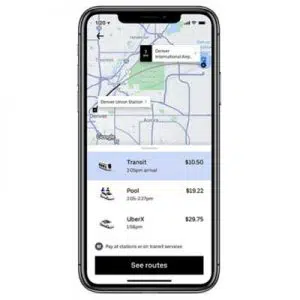Denver light-rail and bus riders will be making a bit of electronic-payments history this spring and summer by being the world’s first commuters able to use Uber Technologies Inc.’s mobile app to buy and use transit tickets.
The new service, which will be rolled out over the next few weeks, was announced Thursday by transit fare-payment technology provider Masabi Ltd. along with Denver’s Regional Transportation District and Uber. London-based Masabi, which has U.S. headquarters in New York City, said in a joint news release that purchasing of transit tickets via Uber is enabled through Masabi’s Justride software development kit. The company claims the Justride is the only SDK of its kind.
Critics of ride-share services such as Uber and Lyft Inc. have claimed the services have undercut mass-transit ridership in recent years. But Uber and Lyft both have been eyeing ties-ups with agencies that enable their riders to get to and from transit stations or bus stops, and view transit schedules. Uber mentions transit as a growth market in the registration statement it filed recently for an initial public offering , and both it and Lyft have working with Denver’s RTD to enable riders to get information about transit options. Now payments are an option with Uber.

A spokesperson for San Francisco-based Uber tells Digital Transactions News by email that he doesn’t have numbers on first-day usage of the payment feature through the app. Uber might release some data in the summer, he says.
Purchases of RTD tickets with Uber, including three-hour, day, and monthly passes, will cost the same as with existing fare options, the parties said. After riders enter a destination in the Uber app, they will see “Transit” as an option in the “choose a ride” selector. Upon selecting that option, riders can buy tickets, and see real-time schedules and walking directions to and from transit stations. Users activate tickets, which are stored in the app’s “Transit tickets” section, when boarding a train or bus. Once purchased, tickets are available even when riders are offline, the release says.
“This project broadens our reach and stays at pace with the public’s needs, allowing people to plan and pay for trips from start to finish,” RTD chief executive and general manager Dave Genova said in the release.





